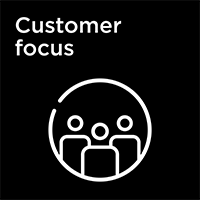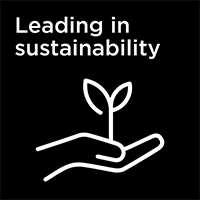On three!


Delivering on Clariant's purpose »Greater chemistry - between people and planet.«
This story is an example of how Clariant delivers on its purpose-led strategy.
»We want to be at the forefront of our industry in bringing sustainable solutions to our customers,« says Nicola Comiotto, Clariant's Head of Procurement. »And our suppliers are very committed to working with us on this goal.« That will prove crucial for Clariant to reach its ambitious climate targets approved by the Science Based Targets initiative (SBTi). They include reducing Scope 3, Category 1 greenhouse gas (GHG) emissions by 14 percent between 2019 and 2030. This is particularly impressive, considering the origin of Scope 3 GHG emissions.
Harder to tackle
Scope 1 emissions are direct greenhouse gas emissions from sources a company owns, operates, or controls. An example could be a furnace or a diesel-powered truck a company uses on-site. Meanwhile, Scope 2 emissions are related to a company's energy purchases – typically electricity, steam, or heat. Hence, both Scope 1 and 2 emissions are from sources an organization owns or controls directly.
Scope 3 emissions, on the other hand, are caused by upstream and downstream activities in the value chain that a company does not own, operate or control directly. That makes Scope 3 emissions especially hard to track and even harder to tackle. Scope 3 emissions are clustered into 15 different categories. Category 1 includes all emissions caused by the goods (materials or products) and services a company buys.
The Scope 3 emissions are of particular concern to Nicola Comiotto in particular and to Clariant overall. That is because most GHG emissions at Clariant are Scope 3 emissions, which amounted to a total of 3.47 million tons of CO₂ equivalents in 2022. And close to 75 percent of the Scope 3 emissions come from Category 1 related to purchased goods and services. Compare that to the 0.64 million tons of GHG emissions Clariant emits in Scope 1 and Scope 2 combined, and it is clear why procurement plays such an essential role in the company's fight against climate change.
»We want to be at the forefront of our industry in bringing sustainable solutions to our customers. And our suppliers are very committed to working with us on this goal.«
Nicola Comiotto, Head of Procurement

Clariant is on track to reach its goals, defined in 2020 in line with the Science Based Targets initiative (SBTi). In 2022 alone, Scope 1 & 2 emissions decreased by 13 percent year-on-year, contributing to the reduction of the product carbon footprints of Clariant’s products. For Scope 3 emissions, Clariant achieved a reduction of four percent. Because Scope 3 emissions make up such a large share, Clariant saved about twice as many tons of CO₂ equivalents in Scope 3 as in Scope 1 and 2 combined.
To achieve this, Clariant works evermore closely with its suppliers and also develops its own solutions, such as its novel product carbon footprint calculator called CliMate, which employs operational data and cutting-edge emissions tracking (for more on this, read this article).
Conscious sourcing
Buying materials and services with less of a carbon burden is very effective: »Over the past years, we have had a particular emphasis on increasing the quality of the emission factors for our raw materials to selectively switch supplies to sources with lower emissions,« says Bettina Siggelkow, Head of Sustainability Affairs at Clariant. For example, Clariant's procurement team works with Jiangxi Fuerxin Medicine Chemical Co., Ltd., a strategic supplier from China. Based in China's eastern Jiangxi province, the firm purchases hydropower and has installed solar panels. Both measures further reduce the carbon footprint of its operations and the products it supplies to Clariant. This collaboration alone yields an emissions reduction of about 870 tons of CO₂ per year.
Clariant's procurement team also strives to increase the use of renewable or even circular materials wherever possible and reasonable – always considering product performance as well as environmental, social, and economic factors across the whole product life cycle. For example, Clariant’s Business Unit Care Chemicals recently unveiled a new range of ethylene oxide derivatives made from renewable bio-ethanol. It developed these components used in home care products as part of a joint venture with its supplier India Glycols.

»Over the past years, we have had a particular emphasis on increasing the quality of the emission factors for our raw materials to selectively switch supplies to sources with lower emissions.«
Bettina Siggelkow, Head of Sustainability Affairs
Impact down stream
Clariant not only deals with more than 20 000 suppliers across all continents, its products are also used in countless markets and applications. And Scope 3 includes all the GHG emissions a company's product may cause during its use and, ultimately, its disposal or recycling. That is why Clariant works with partners along the value chain on making products more sustainable throughout their entire lifecycle. This concept – called cradle-to-cradle – is the driving force behind joint initiatives such as EcoCircle™ and Clariant's Portfolio Value Program (PVP). They emphasize the potential for co-development along the value chain. As a result, many of Clariant's products help to actively reduce GHG emissions through their use, for example, by making processes more efficient or replacing less sustainable materials. GHG emissions that are avoided this way are sometimes counted towards Scope 4 or a company’s carbon handprint – as opposed to its carbon footprint (for more on this, read this article). Partly through partnerships, Clariant Catalysts, for example, helped its customers cut over 35 million tons of CO₂ equivalents in 2022. To put this into perspective, the 35 million tons of CO2e avoided by using Clariant’s catalysts is equivalent to the total CO₂ emissions of Switzerland in 2021.
Scope 1
Scope 2
Scope 3
Scope 4
Direct emissions through own activities Indirect emissions related to energy purchased from third parties Indirect emissions related to upstream and downstream activities in the value chain outside company control Indirect emissions that are avoided by using a company’s product.
Also known as a »carbon handprint«
- Combustion of fuels, including natural gas, coal, diesel, and oil
- Chemical processes generating greenhouse gases, such as CO2, N2O, and CH4
- Electricity
- Steam or hot water
- Cooling
Category 1 includes all emissions caused by the services, products, and materials a company buys. For example, emissions avoided by using catalysts that improve energy efficiency.
What are carbon dioxide equivalents?
Carbon dioxide is the most commonly known greenhouse gas. However, there are many more. From methane and nitrous oxide to octafluorocyclobutane and sulfur hexafluoride, many gases can cause global warming when released into the atmosphere. Their Global Warming Potential (GWP) is indexed to that of carbon dioxide. Thus, all GHG emissions are usually presented in metric tons of carbon dioxide equivalent or CO₂ equivalent (CO₂e). For example, methane has 30 times greater global warming potential than carbon dioxide. For nitrous oxide, the impact is almost 275-fold. To account for this, a ton of methane from fossil fuel origin is represented as 30 tons of CO₂ equivalents. Meanwhile, a ton of nitrous oxide accounts for almost 275 tons of CO₂ equivalents.

